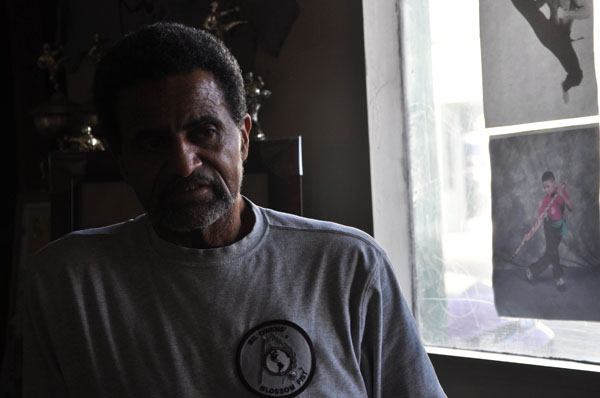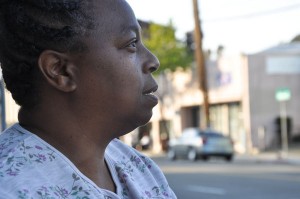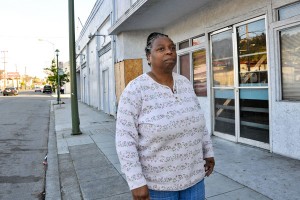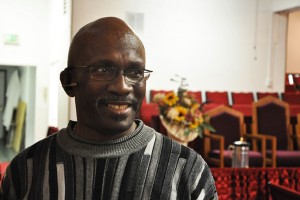
Bill Owens says he’ll never forget what he saw.
He was teaching at Cascos Martial Arts, a karate studio at 74th Ave. and MacArthur Blvd. in East Oakland he’s run with his wife for 40 years, when he heard a series of loud pops.
He thought someone had hit the front window glass or set off firecrackers. Startled and curious, Owens went outside to see where the noise was coming from.
Across the street, he saw two Oakland Police motorcycles sitting idle with their red and blue emergency lights blinking, but he didn’t see the officers. Then he looked down and caught a sight that still haunts him today: Sgt. Mark Dunakin and Officer John Hege, laying mortally wounded on the pavement.
“My authority figure is on the ground,” Bill recalled. “It was really rough and hard to see.”
Bill’s wife Mary also heard the shots and was the first person on the scene rendering aid to the fallen officers. She said both looked dead.
“It was the most horrible thing I’ve ever seen in my life,” she said. “It was inconceivable. I thought I was in a movie.”
Mary started crying. She yelled for her husband, ran back into the studio and called 911.
The healing process has been slow and difficult for both Bill and Mary, who became first responders on the deadliest day in the history of the Oakland Police Department just by going to work on March 21, 2009.
The sight of the bloodied officers and the shell-shock of living and working at the epicenter of the tragedy scarred the couple.
Only recently did Mary go for a walk around the neighborhood again, something she wasn’t able to do for months following the shooting.
Business at the karate studio dropped dramatically following the shootings. It was already suffering from the down economy, but its proximity to the scene of the police slayings drove even more students away.
“People are a bit afraid to come into the area,” Mary said.
Bill tries to make light of the situation: when callers become wary after learning the location of his studio, he jokes over the phone, telling them “lightning never strikes in the same place twice!”
A ‘routine’ traffic stop
The darkest day in the history of the Oakland Police Department began with a routine traffic stop on a warm Saturday afternoon in early spring. It was just after 1 p.m. on March 21, 2009 when Oakland Police Sgt. Mark Dunakin and Officer John Hege pulled over a burgundy Buick sedan for a traffic violation.
They got off their motorcycles, walked up to the driver’s side window together and asked the driver, Lovelle Mixon, for his driver’s license and vehicle registration. The officers had just ran a check on the license and learned there was no DMV record of it when Mixon — a wanted parolee — unexpectedly leaned out of his car window and shot each officer in the head with a semiautomatic handgun. When Dunakin and Hege fell to the ground, Mixon got out of the car and fired more shots at each of them before fleeing on foot down 74th Ave. into an apartment building.
More than 100 cops from Oakland Police and surrounding police agencies raced to the shooting scene. Neighbors described scenes of bedlam as armed police officers combed through the neighborhood in search of Mixon. Nearly two hours later, an Oakland Police SWAT team entered the ground-floor apartment where police informants and eyewitnesses had reported Mixon was hiding. One of Mixon’s sisters lived there with her daughter, but neither was home at the time.
The parolee was barricaded inside, now armed with an assault rifle with a bayonet affixed to the end. When the officers burst through the front door of the apartment, he opened fire. Sgt. Ervin Romans was killed in the initial exchange of gunfire. A second barrage of bullets claimed the life of Sgt. Daniel Sakai. Sgt. Pat Gonzales, the officer credited with shooting and killing Mixon, was also wounded in the shootout.
Mixon’s 16-year-old sister was in the apartment at the time of the forced entry but was able to escape the gunfire. She suffered minor injuries from stun grenades SWAT sergeants released.
Around the corner, the sounds of the gun battle shook Bill and Mary Owens even further. Mary said nothing like this had ever happened to them before.
“Something was really wrong”

Nate Millheim moved his young family to East Oakland in 2008 to launch a faith-based non-profit community center, Shalom of Oakland, to “empower local leaders” and provide a safe place for youth to play and work on homework after school.
He signed the lease for a small space inside a building at 75th Ave. and MacArthur Blvd. just six days before the March 21 shootout.
Millheim was on his way to refurbish the center that Saturday afternoon. But he was met with yellow police crime scene tape and helicopters flying overhead. His center was located in the middle of the manhunt.
“I knew something was really wrong,” he said. “I had never seen so many police.”
Millheim attended the candlelight vigils and prayer sessions following the shootings. He opened the doors of his new community center to those who were impacted by the killings the most. “It’s the people actually here, who live here, who are left in the aftermath,” he said.
“There’s a really small minority of people who come to this neighborhood that are involved in things that you read about in the newspaper. And I think it just kind of grieved me to see this generalization about what happens here — this constant media of ‘oh, how bad it is here.’ That’s frustrating,” Millheim said. “There’s a silent majority of people who are really good people, who are trying to take care of their families, are trying to do their best — they don’t want to see violence.”
He said the aftermath of the shooting brought the community and police closer — especially as beat patrol officers began regularly stopping by his center.
“And just them doing that every once in a while really helped things. When there’s actually a face walking by that says hi, everybody appreciated it,” Millheim said. “It really created a better vibe, as opposed to only seeing a police officer when something goes on and you see them arrest somebody.”
A turning point

Karen King owns a small flower shop down the street, two storefronts away from Cascos Martial Arts on MacArthur Blvd.
She wasn’t at work that Saturday, but she remembers what happened in the days after the shootings well.
The flowers from her shop became part of the many sidewalk memorials in honor of the officers. People from throughout the Bay Area filtered into the area to get a look at the scene of the crime — the spot where the motorcycle officers were killed, and the apartment building where the final shootout occurred.
King said the majority of those she came supported the officers, their hearts heavy with condolences. She described the few who praised Mixon for what he did as “troublemakers.”
The Oakland native said the tragic killings marked a turning point for the effort to revitalize business corridors along MacArthur Blvd. and inspire a neighborhood traumatized by crime.
“I’m really saddened that this happened right here in our neighborhood,” she said.
Before the March 21 incident, efforts to form an East MacArthur Merchants Association were going nowhere.
Afterward, King said there was an “urgency to come together” to improve the area.
A group of between 20 and 25 businesses joined to submit grant proposals to build a community center, beautify sidewalks and implement traffic calming measures along the main boulevard.
They’re “just waiting for documentation to catch up,” King said.
The centerpiece of the revitalization will be a cultural arts center — destined to replace Bill Owens’s secondary karate studio, which now sits vacant because of the downturn in business.
King said they hope to provide an art studio, host monthly art shows, and teach women’s defense as well as dance, cultural, fashion and art classes. The center, she said, will be dedicated in honor of the slain Oakland Police officers.
“There’s more good than bad out there, and nobody writes that,” she said. “We want to help. We want to change the community.”
A department still coping
Oakland Police Assistant Chief Howard Jordan, an OPD officer since 1988, said it was a traumatic day that the everyone on the police force is still coping with.
He attributes the disaster of March 21, 2009 to a lack of officer training, a conclusion new Police Chief Anthony Batts agrees with. “When officers are trained, they are more likely to deal with stressful situations better,” Batts said.
An independent December 2009 report on the causes of the disaster placed blame for the deaths of Sgts. Sakai and Romans on ineffective leadership by Deputy Chief Dave Kozicki, Capt. Rich Orozco and Lt. Chris Mufarreh.
It said responding commanders failed to establish an appropriate command post at the scene, did not have a clear person in charge, and should have heeded warnings that Mixon was in the building.
The report found that commanders dismissed alternatives to forced entry and ordered the SWAT officers into the apartment before a full force was at the scene, even though it had already been determined the situation was too dangerous for police dogs to enter.
There wasn’t even an ambulance on standby in case something went wrong, the report said.
Kozicki retired before the report was released. Other commanders are facing internal discipline — including demotions — because of the report.
The report recommended intensive retraining for officers, covering everything from conducting a routine traffic stop to searching buildings for armed suspects. Of the 24 recommendations in the report, Jordan said the department has so far implemented 15 of them.
Chief Batts, who could have retired with a full pension after three more years as chief of police of the city of Long Beach in Southern California, instead assumed the daunting role of being Oakland’s top cop.
He says he was touched by the outpouring of community grief and was resolved to help a fractured police force heal from the killings.
The list of challenges he faces is immense: low morale, budget restraints, high crime. To cap it all, the events of March 21 are still a sensitive topic of discussion for members of the department one year after the fact.
He said the department has been “beaten and battered,” but affirmed “I wouldn’t be here if I believed this couldn’t change.”
At a neighborhood meeting March 17 in the Oakland hills, Batts presented results from a police department internal survey which emphasized just how immense the challenges were for police officers in the city.
Just 26 percent of Oakland Police officers surveyed said they felt valued by the Oakland community, while only ten percent felt valued by city government.
Only 30 percent said the OPD as an organization cares about them as a person, and a mere 18 percent thought that the department is adequately staffed.
The police chief’s vision for a better department includes more community policing — quelling long-simmering animosity towards law enforcement and fostering better relationships between residents and officers.
Animosity towards police
Bill Owens, the karate studio owner, said he can understand why some members of the community weren’t sympathetic to the slain officers.
“This community has been done really bad by the police,” he said.
Owens recounted how he was harassed by police while performing maintenance on his building at night almost eight years ago.
He said a police officer pulled over and, flashlight in hand, ordered him off his ladder.
Owen dropped his tools, stepped down the ladder, and was handcuffed. He explained who he was, said that he lived right around the corner, and pointed to his large set of keys, which contain a key to every building on the block. He was finally let go.
He said those interactions with police are difficult to forget.
That may be why pastor Keith Martin said the March 21 killings were just another instance of violence in deep East Oakland, an area known to locals as “the Killing Fields” because of the high number of homicides that happen from 73rd Ave. southward to the San Leandro border.
“There is so much constant violence that society has become desensitized,” he said.
Few of his 75 congregants brought the police killings up during services, he said.
What residents really care about are issues of poverty and lack of jobs, Martin said.
A better MacArthur Blvd

The resolve to recover and to improve daily life on MacArthur Blvd. has only strengthened following the March 21 shootings.
Nate Millheim is looking for a larger complex to expand his Shalom Community Center for kids in the neighborhood.
Karen King is eagerly eyeing the grand opening of a cultural arts center just steps away from her business.
Oakland Police Chief Anthony Batts is ready to tackle the monumental task of reducing crime in a city that is notorious for it.
And despite frequent jousting with Oakland city officials over his property, Bill Owens remains committed to his business and his neighborhood.
Last October, when a murder suspect led police into the same 74th Ave. apartment building that parolee Lovelle Mixon had fled into when he shot and killed two SWAT officers, Owens allowed police to use his studio as a makeshift command center.
When the entire street was blocked off, Owens allowed residents unable to enter their homes access to his restrooms.
“I am a part of the community,” he said. “I’m trying to help.”
Nolan Hicks from the Daily Texan newspaper at the University of Texas at Austin and California Beat contributor Steven Luo contributed to this story.

